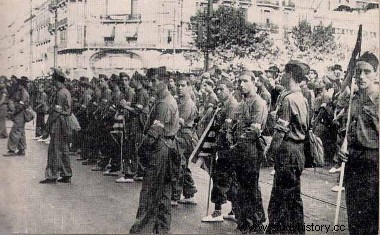
By Me. Cláudio Fernandes
The so-called War Civil Spanish It began in 1936 and lasted until 1939, the year the Second World War began. The period following the end of the civil war became known as Francism , given that General Francis Franco , leader of the Nationalist Front – the winning pole of the civil war – took command of the country.
Until 1936, Spain went through a period of tribulations and tensions in the political sphere. Michael Cousin Rivera , a dictator linked to Spanish conservatism, ruled the country between 1923 and 1930. His regime became known for its authoritarianism with a nationalist bias and the persecution of communists and anarchists who sought to articulate within Spain.
In 1931, the Second Republic was established, with Niceto as president-elect Alcála-Zamora, who remained in power until 1936. Nicetus was succeeded by Manuel Azaña Díaz , whose prime minister was Largo Caballero, a well-known socialist politician. Soon there was growing dissatisfaction with the government of the Second Republic. This dissatisfaction came from the Spanish conservative sectors, the same ones that supported Primo Rivera's government in the 1920s.
These sectors tried to promote a coup d'état and again drive an authoritarian leader to power. However, this time, the coup attempt was not as successful as in Rivera's case. Spanish conservative forces had to face strong resistance from anarchist organizations and the Party Communist Spanish (PCE), which, in turn, was supported internationally by Moscow, the largest center for the spread of communism at the time.
In this atmosphere, the two main lines of combat of the civil war were constituted:the Popular Front , which concentrated the forces of the left, and the National Movement , which in turn concentrated a large part of the forces of the right, led by General Francisco Franco . Franco's inspiration and support came from Italian fascism and German Nazism, which served as a reference for his political perspective. The nationalists were opposed to liberalism and representative democracy, which they considered outdated and fragile models of politics and, henceforth, incompatible with the situation that Spain was experiencing in the 1930s.
During the war, Francisco Franco's nationalists had support from the fascists and Nazis, while the Popular Front republicans received support from international communism, especially the USSR. The supply of weapons, trained fighters and sophisticated equipment for combat and war strategies was on the list of supporters of the conflict.
In addition, several volunteers from various regions of the world also participated in the Spanish Civil War, as was the case with writer George Orwell. The conflict resulted in enormous destruction of the main Spanish urban centers and served as an “announcement” of the catastrophe that would come with the Second World War.
* Image credits: Commons
Take the opportunity to check out our video lesson related to the subject:
